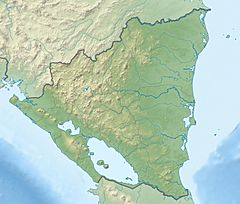Cosigüina facts for kids
Quick facts for kids Cosigüina |
|
|---|---|

Cosigüina crater lake, 2009
|
|
| Highest point | |
| Elevation | 872 m (2,861 ft) |
| Geography | |
| Location | Chinandega Department, Nicaragua |
| Geology | |
| Mountain type | Stratovolcano |
| Last eruption | August 1859 |
Cosigüina (also spelled Cosegüina) is a large stratovolcano in western Nicaragua. It forms a big piece of land that sticks out into the Gulf of Fonseca. The top of the volcano has a huge bowl-shaped area called a caldera. This caldera is about 2 by 2.4 kilometers wide and 500 meters deep. Inside it, there is a beautiful crater lake known as Laguna Cosigüina.
This volcano has grown inside an older, larger caldera. This makes it a special type of volcano called a somma volcano. You can still see parts of the older caldera rim on the north side. However, the newer volcano has covered most of the old rim.
Contents
Cosigüina's Volcanic History
The Cosigüina volcano last erupted in 1859. But its most famous eruption happened on January 20, 1835. This was during the time José Núñez was president of Nicaragua. It was the biggest eruption ever recorded in Nicaragua's history.
The Great 1835 Eruption
Ash from the 1835 eruption traveled very far. It was found in places like Mexico, Costa Rica, and even Jamaica. Scientists at Berkeley Earth Surface Temperature studied this eruption. They found that it caused Earth's average land temperature to drop. The temperature went down by about 0.75 degrees Celsius for a short time.
Recent Activity and Quiet Times
Cosigüina has not erupted since 1859. In terms of how old the Earth is, this is a very short time! In 2002, scientists noticed many small earthquakes near Cosigüina. This showed that the Earth's plates are still moving in that area. Even though Cosigüina is a bit separate from other active volcanoes in Central America, these earthquakes mean things are still happening deep underground.
Today, there are only a few signs of heat or gas from the volcano. Sometimes, you can see gas bubbles in Laguna Cosigüina. There is also a hot spring on the eastern side of the volcano. The sides of the volcano are mostly covered in plants. This shows that there aren't many places where gas is escaping or where it's very hot. The volcano stands 872 meters tall.
See also
 In Spanish: Volcán Cosigüina para niños
In Spanish: Volcán Cosigüina para niños
- List of volcanoes in Nicaragua


